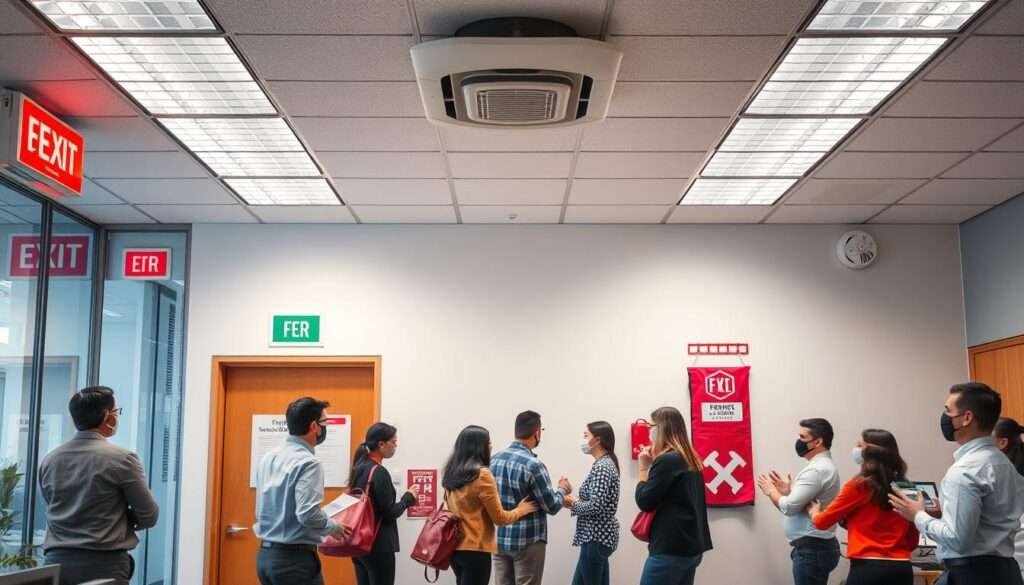Fire Safety guidelines for the workplace:
In India, keeping employees safe is a big deal for all businesses. Fire safety and emergency plans are key. This article will guide you on the must-do fire safety steps for every workplace in India. These steps help protect people, assets, and follow the law.

Key Takeaways:
- Make a strong fire safety policy to cut down risks and follow the rules.
- Use good fire prevention methods, like safe storage of flammable stuff.
- Do fire risk checks often to find and fix dangers.
- Put in and keep up fire alarm systems to quickly warn people in emergencies.
- Teach employees how to use fire extinguishers well so they can act fast.
- Make and practice emergency exit plans to keep everyone safe and in order during fires.
- Make sure all employees know about fire safety by training them often.
Importance of Fire Safety guidelines for the Workplace
Fire safety is key in keeping workplaces safe. Fires can cause huge damage, including loss of life and property. Employers must protect their employees and assets.
Understanding the Risks
Workplaces face many fire risks, like electrical problems and flammable materials. These dangers depend on the workplace type and activities. Employers must act fast to prevent fires.
Legal Obligations and Liabilities
Employers have to follow fire safety legal obligations that change by location. They must have fire safety plans and train employees. Not following these rules can lead to big fines and legal trouble.
Keeping workplaces safe is not just the law. It’s also crucial for protecting everyone and the business. By understanding and meeting fire safety legal obligations, employers show they care about their people and business.
Establishing a Fire Safety Policy
Making a detailed fire safety policy is key to keeping any workplace safe. It lays out who is responsible, what to do in emergencies, and training needs. This is vital for preventing and handling fires at work.
At the core of a good fire safety policy are a few important parts:
- Assigning fire safety roles and duties to certain people
- Clear emergency response plans, like evacuation and fire extinguisher use
- Fire safety training for everyone, so they know their roles and the policy
- Regular updates to the policy, to keep it current with new rules and practices
Having a strong fire safety policy shows a company’s dedication to safety. It makes sure the workplace fire safety plan is effective and current. This protects employees, saves property, and avoids legal issues if a fire happens.
“A well-crafted fire safety policy is the cornerstone of a fire-resilient workplace. It empowers employees to be active participants in maintaining a safe environment.”
The success of a fire safety policy relies on everyone working together. From managers to staff, creating a culture of safety awareness is crucial. This way, companies can keep their people safe and reduce fire risks.
Fire Safety Guidelines for the Workplace
Keeping the workplace safe is key, and fire safety rules are a big part of that. We’ll look at important steps to prevent fires, spot them early, and keep everyone safe in emergencies.
First, fire extinguishers must be in the right spots and work well. They need to be easy to find and checked often. Also, everyone should know how to use them right away if a fire starts.
Having clear plans for getting out of the building is also vital. This means knowing the best ways to leave, where to meet up, and how to handle emergencies. Fire drills help everyone know what to do, making it safer and less scary.
| Fire Safety Guideline for the workplace | Importance |
|---|---|
| Fire Extinguisher Placement and Training | Ensures prompt response and effective fire suppression |
| Emergency Evacuation Procedures | Enables a coordinated and efficient evacuation in case of fire |
| Fire Alarm Systems and Maintenance | Provides early detection and alerts to enable a timely response |
| Fire Risk Assessments | Identifies potential fire hazards and helps implement preventive measures |
Following these fire safety rules can greatly lower the chance of fires and keep everyone safe. It’s not just the law in many places; it’s also the right thing to do to protect lives and property.
Fire Prevention Measures
Effective fire prevention is key to a strong fire safety program. It starts with managing combustible materials well and keeping electrical use safe. By focusing on these areas, we can lower fire risks and keep our people, things, and places safe.
Controlling Combustible Materials
Managing combustible materials is a main fire prevention step. We need to keep flammable liquids, gases, and other dangers away from sparks. Regular checks and clear rules for handling these items help a lot.
Electrical Safety Practices
Keeping electrical safety in check is also vital. We should check electrical gear, wiring, and plugs often for problems. A good maintenance plan for electrical stuff helps catch and fix fire risks early. Teaching employees how to safely use electrical devices and what to do in emergencies is also important.
By using these fire prevention measures, combustible materials management strategies, and workplace electrical safety practices, we make our workplace safer. It’s ready to face and handle fire emergencies better.
Fire Hazard Identification and Assessment
Keeping a workplace safe is a big deal for any company. Spotting and checking fire hazards is key. This helps protect workers, stuff, and the whole business.
Conducting Regular Fire Risk Assessments for the Workplace
Fire risk checks are the heart of fire safety plans. They look closely at the workplace for fire dangers. This includes checking the building, what can catch fire, fire safety steps, and worker readiness.
- Find fire start points, like electrical stuff, heaters, and flames.
- Check how flammable things are that are stored or used at work.
- See if fire detection and stopping systems work well.
- Make sure escape paths and doors are good.
- Follow fire safety laws and building rules.
Doing these checks often helps tackle fire dangers early. It makes the workplace safer and shows the company cares about its people and things.
“Finding and checking fire dangers early is key to a safe work place. Regular checks help us stay on top of risks and take action to prevent them.”
Good fire danger spotting and detailed risk checks are the base of a strong fire safety plan. By tackling these important steps, companies can cut down fire risks and keep their workers safe.
Fire Alarm Systems and Maintenance
Fire alarm systems are key to keeping workplaces safe. They give early warnings of fires, helping everyone get out quickly. With advanced smoke detectors and control panels, these systems are vital for any workplace.
Keeping fire alarm systems in top shape is crucial. Our team checks and tests them regularly. This ensures they work well and catch any problems early.
Regular checks not only keep us safe but also meet fire safety laws. Following National Fire Protection Association guidelines, we know our systems are ready for emergencies.
Types of Fire Alarm Systems
- Conventional fire alarm systems: These basic systems use individual detectors connected to a central control panel, providing a straightforward and cost-effective solution for smaller workplaces.
- Addressable fire alarm systems: More advanced systems that can identify the specific location of a fire, allowing for targeted response and faster resolution of any issues.
- Wireless fire alarm systems: Innovative solutions that eliminate the need for extensive wiring, making them a flexible and easy-to-install option for many workplaces.
No matter the type, we’re dedicated to keeping them working well. Regular maintenance and testing keep our fire detection systems ready to protect us.

“A well-maintained fire alarm system is the first line of defense against workplace fires.”
Fire Extinguisher Placement and Training
Having the right fire extinguishers in the right places is key to workplace safety. It’s also important to train employees on how to use them. This way, we can all be ready to handle fires quickly and safely.
Types of Fire Extinguishers
There are many types of fire extinguishers, each for different fires. Knowing which one to use is crucial. Here are some common ones:
- Class A: Good for fires in paper, wood, and cloth.
- Class B: Works well on flammable liquids and gases.
- Class C: Best for fires in electrical equipment.
- Class K: Made for fires in cooking oils and fats.
Proper Usage and Maintenance
Using fire extinguishers correctly and keeping them in good shape is vital. Employees need to know how to use them right, like the PASS method. Also, regular checks and services are needed to keep them working well.
| Fire Extinguisher Type | Suitable for | Maintenance Recommendations |
|---|---|---|
| Class A | Ordinary combustible materials | Monthly visual inspection, annual maintenance |
| Class B | Flammable liquids and gases | Monthly visual inspection, annual maintenance |
| Class C | Energized electrical equipment | Monthly visual inspection, annual maintenance |
| Class K | Cooking oils and fats | Monthly visual inspection, annual maintenance |
By focusing on where to put fire extinguishers and training employees, we can all be ready for fires. This reduces the risk of injury and damage.
Also Read : Fire Safety Guidelines for Schools in India
Emergency Evacuation Procedures
In case of a fire or emergency, having clear evacuation plans is key. Our workplace focuses on quick and safe evacuation of everyone. This helps avoid injuries and saves lives.
Establishing Evacuation Routes and Assembly Points
We have set up clear emergency evacuation paths in our facility. These paths are easy to find and marked with signs. They lead to safe fire assembly points.
- Evacuation routes are chosen for their safety and shortest path to the nearest fire assembly point.
- Assembly points are far enough from the building to be safe. They are where all employees gather.
- We hold regular fire drills. This helps everyone know the evacuation routes and where to go.
By having clear plans and practicing them, we keep our team safe in emergencies.
“Preparation is the key to effective emergency response. By establishing and regularly rehearsing our evacuation procedures, we can minimize the risk and ensure the safety of our employees.”
Employee Fire Safety Awareness and Training
It’s vital to make sure employees know about fire safety and get the right training. This helps keep our workplace safe. It also lowers the chance of big problems happening.
Good fire safety training covers many things. It includes how to prevent fires, what to do in an emergency, and how to use fire safety tools. Regular classes teach our team how to spot and stop fires. They also learn how to act if a fire happens.
Key Components of Employee Fire Safety Awareness and Training
- Fire prevention strategies, such as proper storage and handling of flammable materials
- Identification and reporting of potential fire hazards
- Proper use and maintenance of fire extinguishers and other fire safety equipment
- Emergency evacuation plans and designated assembly points
- First-aid and fire-fighting techniques
- Ongoing refresher training to ensure staff remain up-to-date on fire safety protocols
By focusing on fire safety awareness and workplace fire safety training, we make our team safer. This keeps our workers safe and helps us follow the law. It also reduces the risk of legal problems if a fire happens.
“An ounce of prevention is worth a pound of cure. Investing in comprehensive fire safety training for our employees is a proactive measure that can save lives and protect our business in the long run.”

| Training Topic | Frequency | Responsible Party |
|---|---|---|
| Fire Prevention and Hazard Identification | Quarterly | Fire Safety Manager |
| Fire Extinguisher Usage and Maintenance | Bi-annually | Facilities Manager |
| Emergency Evacuation Procedures | Annually | Safety Coordinator |
Fire Safety Regulations and Compliance
In India, workplaces must follow strict fire safety rules. It’s important for business owners to know and follow these rules. This ensures the safety of employees and avoids legal trouble.
The main fire safety rules include the National Building Code of India and the Factories Act. The National Building Code gives detailed guidelines for fire safety in buildings. The Factories Act has specific fire safety rules for factories.
To follow these rules, businesses must take several steps:
- Do regular fire risk assessments to find potential dangers.
- Put in place fire prevention and control steps.
- Make sure fire alarm systems and extinguishers are installed and kept in good shape.
- Give all employees thorough fire safety training.
- Do fire drills often to check emergency plans.
By following fire safety regulations and having a strong Fire safety guidelines for the workplace compliance plan, businesses can keep their places safe. They also protect their workers and avoid legal and financial problems.
| Key Fire Safety Regulations in India | Key Requirements |
|---|---|
| National Building Code of India | Fire prevention and protection measuresFire safety systems and equipmentEmergency evacuation planning |
| Factories Act | Fire safety requirements for industrial facilitiesMandatory fire safety equipment and trainingRegular fire risk assessments and drills |
By focusing on fire safety regulations and keeping up with workplace fire safety compliance, Indian businesses can keep their operations safe. They also show they care about creating a safe and responsible work place.
Workplace Fire Drills
Regular fire drills are key to workplace fire safety. They help us test and improve our emergency plans. This ensures our team is ready to act fast if a fire happens.
Conducting Regular Fire Drills
Fire drills check if our safety plans work well. They show us where we can do better and if our team knows what to do. Doing fire drills often, like once or twice a year, keeps us ready and helps us get better.
Evaluating and Improving Fire Drill Procedures
After each drill, we need to review it carefully. We listen to what our team says, watch how the drill goes, and find ways to get better. This helps us make our drills better and our team more ready for real fires.
By focusing on fire drills, we build a safe work culture. Regular drills and reviews make us more prepared and show we care about our team’s safety. Keeping our fire drill procedures sharp is key to a safe and quick response to fires.
Conclusion
Effective fire safety guidelines for the workplace are key for workplaces in India. By focusing on prevention and having emergency plans, businesses can lower fire risks. This protects their most important asset – their employees.
Having a strong fire safety program shows a business cares about its workers. It meets legal needs and shows commitment to safety. Regular checks, well-maintained alarms, and training all help create a safe space.
By following these guidelines, Indian businesses can improve safety and meet legal standards. This ensures the success and growth of their operations. As employers, we must make fire safety a top priority. We should aim to create a culture of safety and readiness in our workplaces.
FAQ
What are the key fire safety guidelines that every workplace should follow?
Every workplace should have a fire safety policy. They should also prevent fires, do regular risk assessments, and have reliable alarm systems. It’s important to place fire extinguishers correctly and train employees on them. They should have good evacuation plans and make sure everyone knows about fire safety.
Why is fire safety so important in the workplace?
Fire safety is key because fires can cause a lot of harm. They can hurt people, damage property, and stop businesses from working. Employers must protect their workers and property by following fire safety rules and taking the right steps.
What are the key elements of a fire safety policy?
A good fire safety policy should name who is in charge, have emergency plans, and include training and drills. It should also have a way to update the policy to keep it effective.
How can we prevent fires in the workplace?
To prevent fires, control flammable materials, use safe electrical practices, and check equipment regularly. This helps lower the fire risk.
What are the different types of fire extinguishers, and how should they be used?
There are many fire extinguishers, each for different fires. It’s important to train employees on how to pick and use them right. This ensures they can fight fires effectively.
How should we prepare for emergency evacuation in the workplace?
To prepare for evacuations, make clear paths, pick safe meeting spots, and do fire drills. This makes sure everyone knows what to do and can get out safely.
What fire safety regulations do workplaces in India need to comply with?
Workplaces in India must follow the National Building Code and the Factories Act. Following these rules is important for keeping employees safe and avoiding fines.
How can we ensure our employees are well-prepared for fire emergencies?
Give employees detailed fire safety training and awareness. Teach them about preventing fires, how to respond in emergencies, and how to use fire safety gear. Regular drills help make sure they can act fast and right in a real fire.








1 thought on “Essential Fire Safety Guidelines for the Workplace”
Pingback: Fire Safety Checklist for Industries
Comments are closed.